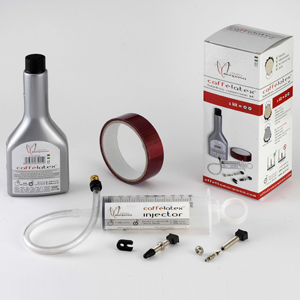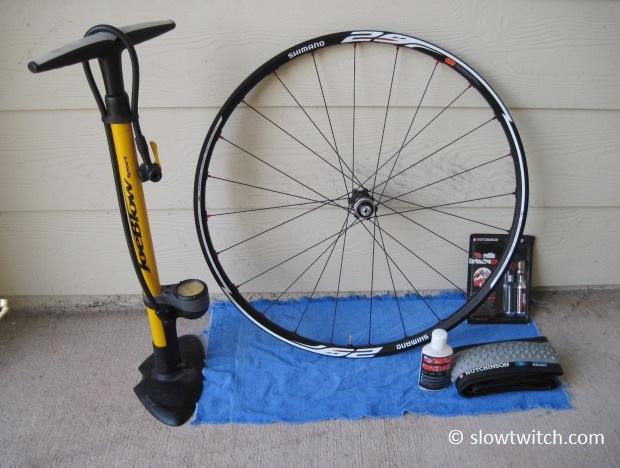Caffelatex for 2013
If you’ve read any of my material, you probably know that I’m a fan of tire sealants. There are many types out there. If you’re unfamiliar with tire sealants in general, you may want to take a look at our primer on all-things-sealant, located HERE.
Given my affinity for sealants, I was pleased to learn that Italian-based Effetto Mariposa recently released an updated formula of their beloved Caffelatex.

Caffelatex stands as only one of two major sealants on the market that are synthetic latex-based (the other being Continental’s new Revo sealant). Most of the competition is either made from natural latex, or some blend of propylene or ethylene glycol.
The natural latex products tend to work well at their primary job – sealing punctures. They can suffer, however, in their longevity. The more arid a climate you live in, the faster it will evaporate. Evaporate, you ask? Yes – sealant will evaporate right through the walls of your tire and/or tube (which are actually quite porous). What you end up with are dried chunks of latex inside of your tire, and no more puncture-sealing juice. The other problem is that nearly every natural latex sealant contains at least some amount of ammonia, which has been reported to damage rims and inner tubes over time.
The glycol-based sealants don’t suffer the quick drying or corrosion problems, but they suffer another potential problem – long-term sealing (or lack thereof). I generally like glycol-based sealants, as they’re inexpensive and easy to use. They also last about 5-10 times longer than latex sealants before drying out. However, I would not rely on them as a ‘forever fix’. I see them as something to get you to the end of the race or ride – and then change your tube or tubular tire. They do not work with road tubeless applications, so that discussion is a non-issue (the only tubeless application they do work in is mountain UST tubeless – which does not require any sealant at all to hold air in the tire).
So, we’re left with this third category of synthetic latex sealants. In theory, they could quite possibly be the best of all worlds. They do dry over time (which helps seal punctures) – but they don’t seem to dry quite as fast as the natural latex sealants. They don’t contain ammonia, so your rims and inner tubes are safe. In fact, Caffelatex is the only sealant recommended by the high-end tire manufacturer, Dugast. Their tubular tires use latex inner tubes, which tend to be more delicate than butyl rubber. As well, Shimano unofficially endorses Caffelatex as the best and safest sealant for use in their tubeless wheels.
Caffelatex is unique in its special foaming action – said to help deal with sidewall cuts:

But is it really better? Does synthetic latex really take the cake? Anecdotal evidence from my years in cycling ended up at this conclusion: Yes it’s safer for your tires and tubes. Yes, it offers better long-term puncture repairs than glycol sealants. But… but! But no – it doesn’t seal quite as well as natural latex. To be frank, Stan’s NoTubes is the standard (and it is natural latex-based). They have a huge following and a well-established product, especially in the mountain bike community.
However – if the new Caffelatex formula does everything they say it can do – we could have a new all-around winner on our hands.
New Caffelatex
Head man at Effetto Mariposa, Alberto De Gioannini, tells me that while the old Caffelatex was good, the new stuff has been improved in one critical area. The old formula tended to suffer in very lightweight cross country mountain bike tires. Racers will often use a tire that is specifically not intended to be used without a tube – and use a conversion kit to make it tubeless. What you can end up with is a VERY lightweight, but frail tire (think 400g for a 29×2.0” tire). If you don’t speak mountain bike, that translates to really, really light. My brain deduces that if the sealant works better in that worst-case scenario, it will also work better in road applications.
How do we quantify how much better the new brew is? According to Gioannini, it will seal a 4mm puncture in a tubeless mountain bike tire five times faster than the old formula. If you’re JRA (just ridin’ along), and hit a sharp rock or thorn, it takes some time for that sealant to roll around and find the puncture. If the old sealant took 25 seconds to seal said puncture, the new sealant only takes five seconds.
Given such a huge change, I was curious how they did it. According to Gioannini:
“What makes the difference? It's basically the addition of a small percentage of microscopic silicate particles that affect the flowing characteristics: the new CL flows slower through holes (that doesn't affect macroscopic properties like viscosity). It’s a subtle change that makes a huge difference.”
The folks at Effetto Mariposa sent a few bottles of the new sealant to me, and I look forward to putting it through the paces. I’ve had the ‘old’ Caffelatex in one of my mountain bikes since May 2012, and – knock on wood – haven’t had any punctures yet (that I’m aware of). For those who use Road Tubeless, Caffelatex is approved for its use. The price is $10 for a 250ml bottle, or $30 for 1,000ml.
Accessories from Effetto Mariposa
Giustaforza torque wrench
Aside from tire sealant, Effetto Mariposa makes a host of other interesting products. Their first-ever product actually had nothing to do with tires at all – it was a torque wrench:

The Giustaforza works from 2 to 16 Newton Meters, and is said to be accurate +/- 4%. It includes a variety of essential bits, including all major hex and Torx sizes used on bicycles. Effetto Mariposa guarantees that the calibration will hold true for 5,000 cycles (or ‘clicks’), and they offer a re-calibration service for those who exceed this. Ham-fisted mechanics (you know who you are): Put this on your list from Santa or other gift-carrying holiday character. Your stem bolts will thank you later. MSRP $250
Shelter carbon tape
What is Shelter? Effectively – it does what a clear ‘bra’ does for the front of your car’s hood. Shelter is a clear adhesive tape made specifically to protect your expensive carbon frame from scratches and impacts. It is 1.2mm thick, and works by spreading out the area of impact from that devilish rock that flies up from the pavement or trail.

Shelter sells for $30; the package includes two 55 x 500mm sheets (roughly 2 x 20”) – an investment that could very well save a $5k+ frame from certain death.
Espresso
Sure, I’d love one… make it a double.
No, not that kind of espresso (although I would love one right about now)… the ‘Espresso’ from Effetto Mariposa is their version of fix-a-flat. Call it Caffelatex-in-a-can. This is intended as an all-in-one C02 plus sealant that you can use on the road to seal your puncture and inflate the tire in a single step.

To be honest, I was very skeptical of this product before trying it myself. I’ve tried competitors’ fix-a-flat inflators with a precise success rate of zero percent. None of them worked. I decided to give Espresso the old college try after coming back from a mountain bike ride with my better half. Her bike has standard tires and butyl inner tubes. Autumn in Colorado means that there are tiny ‘goat head’ thorns everywhere – which have a great reputation for sticking in your tires and causing a slow leak. Her rear tire had three of them.
I pulled the thorns out, put the Espresso tube on the valve, and shot the tire full of sealant. And waited. And… waited? It actually seemed to work. The tire held air. Impressed, I hung the bike up and walked away. 24 hours later, I went back to check on it. The tire had gone from maybe 40 psi to 35, but it was still holding quite well. On day two, it had lost a little more. Day three was the first time I’d really call the tire ‘soft’ again.
Half of the air loss can be chalked up to the fact that the Espresso uses C02 gas – and ALL C02’s leak down faster than air due to the smaller molecule size. The sealant itself did astoundingly well, especially considering it is thin enough to inject through a valve core. If this was a race situation, the Espresso would have definitely done its job of getting you through the end of the bike segment. Heck… you could have finished the bike, run a 10k, gotten your award, and ridden the bike all the way home – and it would still have plenty of pressure in the tires.
The other beauty of the Espresso injector is the fact that it has a flexible plastic tube for injection, unlike some other fix-a-flat inflators. This means that it will work with disc wheels, or anything with a valve cutout (i.e. Hed’s H3 wheels). The price isn’t necessarily cheap at $14, but that’s a small price to pay for avoiding a race-day disaster.
Caffelatex injector
The Caffelatex Injector is simply a syringe with a tube that can be used to inject Caffelatex (or any sealant) in to your tire.

The injector is graduated for accurate measurement, and has a capacity of 100ml. The key distinction between this and the Stan’s injector is an important one – the Caffelatex injector’s tube does not have to thread on to your valve (it is pictured above with the optional threaded adapter, which can be easily removed). While the threading feature is nice, it makes the Stan’s injector incompatible with all non-threaded valves (i.e. all Continental tubular tires). The Caffelatex injector works with any valve on the market.
Valve Extenders
Effetto Mariposa has their own version of the removable-core valve extender. These are simple and effective. They tie with Stan’s as my favorite, due to a simple feature: external threading. Having the entire body of the extender externally-threaded helps your pump get a firm ‘bite’. Some of the non-threaded designs require that you hold the pump head on with one hand while inflating (otherwise it can come flying off).
They are 40mm long, and can be stacked up for use on super-deep rims. Price is $15 for a pair, including a small wrench that aids in installation.

Bag-o-Presta cores
This is my personal favorite new product from Effetto Mariposa. It’s also by-far the most boring. What is it? A bag of ten Presta valve cores:

Boring? Yes. Essential? YES! If you use sealant – any sealant – you want to keep spare presta valves handy. The reason is simple: over time, sealant gunks up your valve core. You see, sealant isn’t that smart. It can’t tell the difference between a puncture in your tire, and the hole at the opening of your valve. All the sealant knows is that it wants to clog stuff up. After your valve core gets sticky, the only fix is to throw it away and put a new one in. They’re cheap, and great to keep around as spares.







Start the discussion at forum.slowtwitch.com